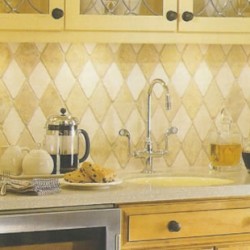Put Ceramic Tile in the Kitchen?
When you look at it more closely, you’ll see that tile does have its place in the kitchen–but not necessarily everywhere. Let’s take a look at where tile works best in the kitchen; where it doesn’t; and where you could kinda go either way.
Best: Tile Backsplash

Ceramic tile probably works best in the kitchen for backsplashes.
The backsplash is the border of whatever-material-you-choose that acts as a horizontal border above the countertops. Backsplash materials can range from pressed tin to ceramic tile to granite to absolutely nothing (you really don’t need a backsplash).
As the name implies, it’s supposed to catch splashes. But it also goes behind the stove, and does a bang-up job of preventing grease from runing your walls.
Not only is ceramic tile beautiful as a backsplash, but glazed tile is 100% wipe-able (but remember that the grout lines are not).
So-So: Tile Floor
We suggest using special gel mats or just throw rugs to alleviate the discomfort from standing on ceramic tile for long periods.
Perfect for kitchen? Seems like it. After all, ceramic tile is water-proof and hygenic.
But many cooks don’t like ceramic tile for kitchens for these reasons:
- Everything breakable will absolutely break when dropped on ceramic tile. Other materials (wood, vinyl) will have some “give.”
- Ceramic tile is hard to stand on for long periods.
Worst: Tile Counters
Again, looks beautiful and is mostly waterproof. So, why are many cooks averse to using ceramic tile as kitchen countertops?
- Grout lines hard to clean.
- Not a smooth, flat surface for preparing food (due to those grout lines).
If you really, really want tile counters in your kitchen, you can mitigate those bad things by making sure your grout lines are properly sealed; using bigger tiles to minimize grout lines; installing granite tiles that don’t need grout.